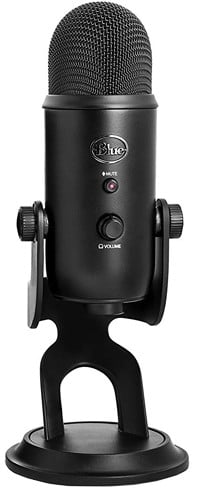HyperX QuadCast vs. Blue Yeti: Which mic is right for you?
While a gamer at heart, I've tested numerous USB microphones extensively for communications on Discord and amateur streaming. We know a thing or two when it comes to choosing the best USB microphone.


Premium USB mic
The QuadCast is HyperX's first standalone USB microphone and it's a superb unit for those who are new to streaming or podcasting. The microphone itself has everything you need and even comes rocking RGB lighting, which you, unfortunately, can't disable.
Pros
- Solid design
- Headphone output
- Good sound quality
- Four polar patterns
- Built-in shock mount
Cons
- Can't turn lighting off

Beastly value
For the price, the Blue Yeti is a great USB microphone, offering excellent sound quality and support for a variety of recording setups. You may find it difficult to fit the Yeti into your standard shock mount, however, due to the odd bulky dimensions of the Yeti.
Pros
- Headphone output
- Good sound quality
- Four polar patterns
Cons
- Odd dimensions for shock mounts
- No shock mount included
All the necessary jargon data that you'd usually parse to see which microphone is better on paper is almost identical, which makes the price and available features the deciding factors. The latter area lands in the favor of the QuadCast, thanks to the pre-installed shock mount to prevent the microphone from picking up knocks or vibrations. This is as important as a pop filter, which is also is pre-installed within the outer chassis.
HyperX, being primarily focused on PC gaming hardware, even added some RGB lighting, making the microphone glow red when it's not muted and recording audio. Where it counts, the Yeti holds up on its own and performs just as well as the QuadCast for actual recordings, once you've played around with system sound settings to reduce white noise and amplify your own voice.
Fighting against shocks and pops
Having both of these features, which the Blue Yeti omits, means you're ready to go with everything you need for recording audio as soon as you've unboxed it. The shock mount is used to help mitigate any vibrations that are passed through the stand or mount to the microphone, while the pop filter shields against the "popping" sound from your voice.
The Blue Yeti may require you to purchase an aftermarket shock mount and pop filter should you require them at a later date, and even then you'll need to make sure the mount can fit the Yeti since it's thicker than most microphones at this price. You're looking at around $20 for a Yeti-compatible shock mount and $13 for a pop filter cover. These bring the total to $133, just shy of the QuadCast price.
Sound-wise, both microphones pick up audio very well, considering the price. While the $40 is a lot to ask for those on tighter budgets, especially when the two microphones are similar in specs, the QuadCast is well worth it for the peace of mind that you're getting all the basics included. Want to save a little? Go with the Yeti.
Battle of the specs
For performance, where the numbers are important for audio quality and actual recording, both microphones are real close. If you're on a tighter budget and don't particularly mind using a shock mount (or have one that fits the Yeti) the Blue Yeti is an excellent buy. If your budget can stretch to the HyperX QuadCast, it's well worth considering because of everything that's included.
| Header Cell - Column 0 | HyperX QuadCast | Blue Yeti |
|---|---|---|
| Frequency response | 20Hz to 20kHz | 20Hz to 20kHz |
| Power | 5V 125mA | 5V 150mA |
| Condensers | 3x 14mm | 3x 14mm |
| Polar patterns | Stereo Omnidirectional Cardioid Bidirectional | Stereo Omnidirectional Cardioid Bidirectional |
| Ports | Micro-USB 3.5mm jack | Micro-USB 3.5mm jack |
| Sensitivity | 1V/Pa at 1kHz | 4.5mV/Pa 1kHz |
The above table may look a little confusing, but all you really need to know from it is the Yeti and QuadCast are similar microphones. Both have three 14mm condensers for picking up audio, support four polar patterns (how sound is recorded from different directions), have identical ports and frequency response. Regardless of which one you choose, you'll be pleased with the recording.
All the latest news, reviews, and guides for Windows and Xbox diehards.
Polar patterns are important when selecting a microphone as this depicts where microphone will record sound within its immediate sphere. Since both the Yeti and QuadCast allow you to switch between different patterns, you'll be able to choose how you want the microphone to pick up the sound, whether you want it to record from all its surroundings or just focus solely on your voice at the front.
Everything you need
Going with the QuadCast from HyperX allows you to get a stream or podcast up and running without having to purchase additional equipment. All you'd need is a decent pair of headphones and you have a quality audio setup.

A superb microphone for streamers
HyperX's first standalone microphone is a fantastic solution for anyone looking to pick up a new mic for streaming, podcasting or communicating with friends and guildmates. The included shock mount allows you to set up the microphone and get started without needing anything else for the ideal configuration.
For those on tighter budgets
Blue Yeti is here for those who don't mind in getting slightly less. You will save money, but have to pick up an aftermarket pop filter and shock mount should you require them at a later date. The microphone is as good as the QuadCast on paper, though it's a little on the thick side.

Tried and tested audio performance
The Blue Yeti is a microphone that has been around for many years and has been part of numerous streamer setups for good reason. It's a very capable microphone that offers some killer recording features and matches the QuadCast on performance. It does fall short slightly on no shock mount being included, but you're saving $40.

Rich Edmonds was formerly a Senior Editor of PC hardware at Windows Central, covering everything related to PC components and NAS. He's been involved in technology for more than a decade and knows a thing or two about the magic inside a PC chassis. You can follow him on Twitter at @RichEdmonds.
